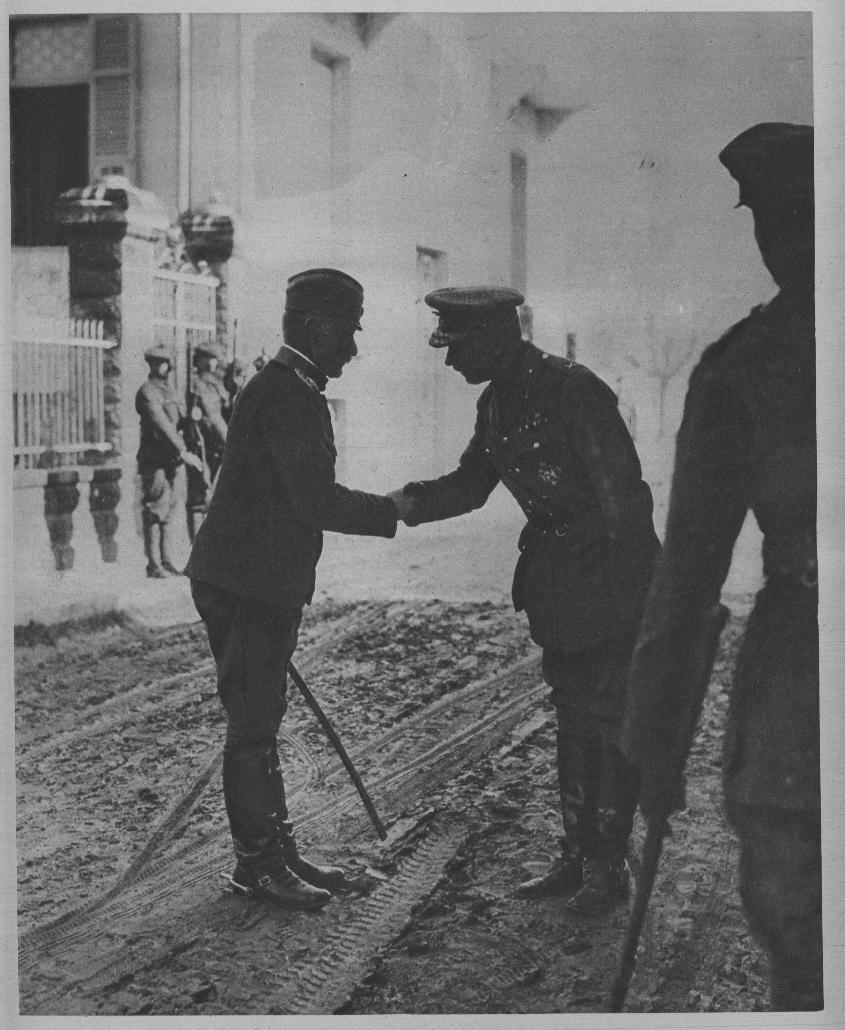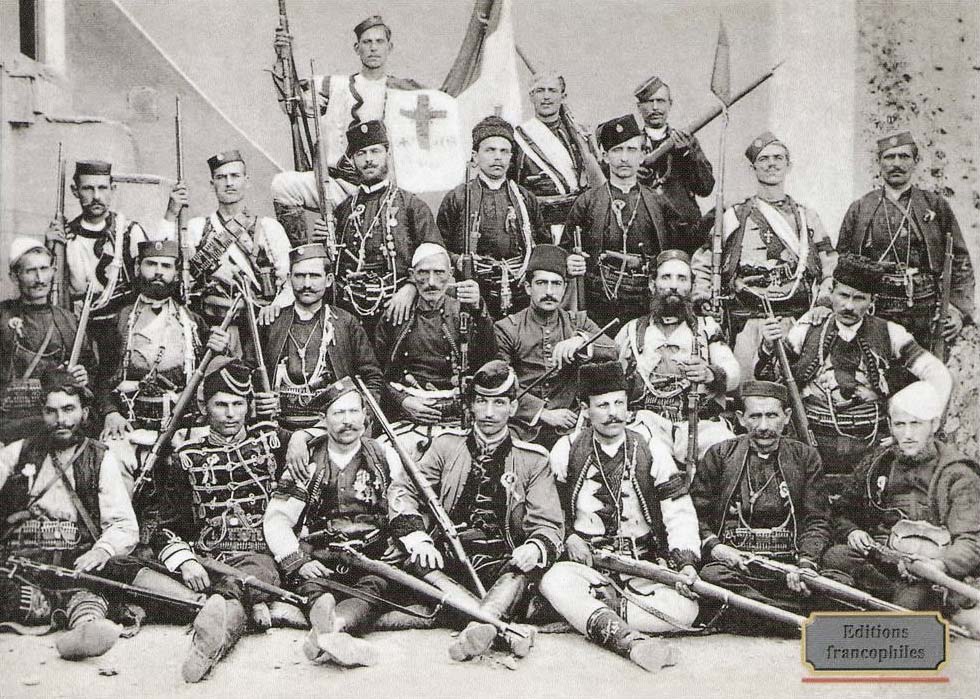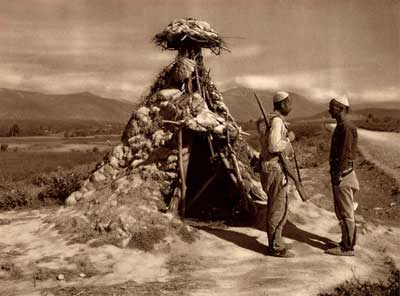|
Vlada Voskar
Vladimir "Vlada" T. Milanović, nicknamed Vlada Voskar ( Arandjelovac, Principality of Serbia, 1880 – Siberia, Russia, before 1922) was a Serbian Chetnik voivode from Arandjelovac. He was a member of Voivode Vojislav Tankosić's band (1903-1912). After participating in the Balkan Wars and World War I, he joined the First Serbian Volunteer Division in Odessa and continued fighting against the Bolsheviks in the White movement. That was the last record of him. As a member of the Serbian Chetnik band, Vlada Voskar and his fellow volunteers were under the command of Vojislav Tankosić, one of the most important Chetnik voivodes at the time. They went to Skopje, Bitola, and Thessaloniki in the winter of 1903–04, where they organized Chetnik action in the struggle for Macedonia. Voskar also participated in the victory on Čelopek near Kumanovo on 16 April 1905, part of the četa (unit) of vojvoda Savatije Milošević. Voskar went to Belgrade after Tankosić disbanded the Chet ... [...More Info...] [...Related Items...] OR: [Wikipedia] [Google] [Baidu] |
Belgrade
Belgrade ( , ;, ; Names of European cities in different languages: B, names in other languages) is the Capital city, capital and List of cities in Serbia, largest city in Serbia. It is located at the confluence of the Sava and Danube rivers and the crossroads of the Pannonian Basin, Pannonian Plain and the Balkan Peninsula. Nearly 1,166,763 million people live within the administrative limits of the City of Belgrade. It is the third largest of all List of cities and towns on Danube river, cities on the Danube river. Belgrade is one of the List of oldest continuously inhabited cities, oldest continuously inhabited cities in Europe and the world. One of the most important prehistoric cultures of Europe, the Vinča culture, evolved within the Belgrade area in the 6th millennium BC. In antiquity, Thracians, Thraco-Dacians inhabited the region and, after 279 BC, Celts settled the city, naming it ''Singidunum, Singidūn''. It was Roman Serbia, conquered by the Romans under the reign ... [...More Info...] [...Related Items...] OR: [Wikipedia] [Google] [Baidu] |
Allied Army Of The Orient
upright=1.1, Allied collaboration: an Italian captain, a Russian lieutenant, a Serb colonel, a French lieutenant, and a Greek gendarme The Allied Army of the Orient (AAO) (french: Armées alliées en Orient) was the name of the unified command over the multi-national allied armed forces on the Salonika front during the First World War. When Germany, Austria-Hungary and, the newly joined ally, Bulgaria were about to overrun Serbia, in September–October 1915, the returning multi-national troops from the failed Gallipoli campaign disembarked in the Greek port of Salonika to establish the Macedonian Front. A side-effect of the landing was the further burdening the National Schism between the Greek King and the Prime minister, and the forced resignation of the latter. By August 1916, some 400,000 allied soldiers from five different armies occupied the Salonika front. A unified command imposed itself and after long discussions, French General Maurice Sarrail was placed in command ... [...More Info...] [...Related Items...] OR: [Wikipedia] [Google] [Baidu] |
Salonika
Thessaloniki (; el, Θεσσαλονίκη, , also known as Thessalonica (), Saloniki, or Salonica (), is the second-largest city in Greece, with over one million inhabitants in its metropolitan area, and the capital of the geographic region of Macedonia, the administrative region of Central Macedonia and the Decentralized Administration of Macedonia and Thrace. It is also known in Greek as (), literally "the co-capital", a reference to its historical status as the () or "co-reigning" city of the Byzantine Empire alongside Constantinople. Thessaloniki is located on the Thermaic Gulf, at the northwest corner of the Aegean Sea. It is bounded on the west by the delta of the Axios. The municipality of Thessaloniki, the historical center, had a population of 317,778 in 2021, while the Thessaloniki metropolitan area had 1,091,424 inhabitants in 2021. It is Greece's second major economic, industrial, commercial and political centre, and a major transportation hub for Greece and south ... [...More Info...] [...Related Items...] OR: [Wikipedia] [Google] [Baidu] |
Corfu
Corfu (, ) or Kerkyra ( el, Κέρκυρα, Kérkyra, , ; ; la, Corcyra.) is a Greek island in the Ionian Sea, of the Ionian Islands, and, including its small satellite islands, forms the margin of the northwestern frontier of Greece. The island is part of the Corfu regional unit, and is administered by three municipalities with the islands of Othonoi, Ereikoussa, and Mathraki.https://corfutvnews.gr/diaspasi-deite-tin-tropologia/ The principal city of the island (pop. 32,095) is also named Corfu. Corfu is home to the Ionian University. The island is bound up with the history of Greece from the beginnings of Greek mythology, and is marked by numerous battles and conquests. Ancient Korkyra took part in the Battle of Sybota which was a catalyst for the Peloponnesian War, and, according to Thucydides, the largest naval battle between Greek city states until that time. Thucydides also reports that Korkyra was one of the three great naval powers of fifth century BC Greece, alo ... [...More Info...] [...Related Items...] OR: [Wikipedia] [Google] [Baidu] |
Battle Of Mojkovac
The Battle of Mojkovac was a World War I battle fought between 6 January and 7 January 1916 near Mojkovac, in today's Montenegro, between the armies of Austria-Hungary and the Kingdom of Montenegro. It ended with a decisive Montenegrin victory. Prelude In the winter of 1915, the Montenegrin Army had been fighting the Austro-Hungarian Army for three months in Serbia. In January 1916 they had to resist the invasion of their own territory. The Montenegrin Army was weakened by the harsh weather and lack of supplies. On 5 January 1916, they received a command to protect the retreat of the Royal Serbian Army to Corfu in Greece via Albania. Savo Lazarević was commander of Montenegrin Royal Gendarmerie which was part of Čakor Detachment during the Battle of Mojkovac. Battle The fighting culminated on 6 and 7 January 1916 (on Orthodox Christmas; also known as 'Bloody Christmas'). Led by Serdar ( Vojvoda) Janko Vukotić with Krsto Popović as second in command, the Montenegrins inf ... [...More Info...] [...Related Items...] OR: [Wikipedia] [Google] [Baidu] |
Montenegrin Army
Montenegrin Ground Army ( cnr, Kopnena vojska Crne Gore) is the ground force of the Armed Forces of Montenegro The Armed Forces of Montenegro ( cnr, Војска Црне Горе, Vojska Crne Gore) are the military forces of Montenegro. The Armed Forces consists of an army, navy and air force. The military currently maintains a force of 2,350 active .... Montenegrin Army The fundamental role and purpose of the Montenegrin Army is to protect vital national interests of Montenegro and defend the sovereignty and territorial integrity of the state. Equipment References {{Allied Land Command Military of Montenegro Military units and formations established in 1879 Military units and formations disestablished in 1918 Military units and formations established in 2006 ... [...More Info...] [...Related Items...] OR: [Wikipedia] [Google] [Baidu] |
Sava River
The Sava (; , ; sr-cyr, Сава, hu, Száva) is a river in Central and Southeast Europe, a right-bank and the longest tributary of the Danube. It flows through Slovenia, Croatia and along its border with Bosnia and Herzegovina, and finally through Serbia, feeding into the Danube in its capital, Belgrade. The Sava forms the main northern limit of the Balkan Peninsula, and the southern edge of the Pannonian Plain. The Sava is long, including the Sava Dolinka headwater rising in Zelenci, Slovenia. It is the largest tributary of the Danube by volume of water, and second-largest after the Tisza in terms of catchment area () and length. It drains a significant portion of the Dinaric Alps region, through the major tributaries of Drina, Bosna, Kupa, Una, Vrbas, Lonja, Kolubara, Bosut and Krka. The Sava is one of the longest rivers in Europe and among the longest tributaries of another river. The population in the Sava River basin is estimated at 8,176,000, and is shared ... [...More Info...] [...Related Items...] OR: [Wikipedia] [Google] [Baidu] |
Austro-Hungary
Austria-Hungary, often referred to as the Austro-Hungarian Empire,, the Dual Monarchy, or Austria, was a constitutional monarchy and great power in Central Europe between 1867 and 1918. It was formed with the Austro-Hungarian Compromise of 1867 in the aftermath of the Austro-Prussian War and was dissolved shortly after its defeat in the First World War. Austria-Hungary was ruled by the House of Habsburg and constituted the last phase in the constitutional evolution of the Habsburg monarchy. It was a multinational state and one of Europe's major powers at the time. Austria-Hungary was geographically the second-largest country in Europe after the Russian Empire, at and the third-most populous (after Russia and the German Empire). The Empire built up the fourth-largest machine building industry in the world, after the United States, Germany and the United Kingdom. Austria-Hungary also became the world's third-largest manufacturer and exporter of electric home appliances, elect ... [...More Info...] [...Related Items...] OR: [Wikipedia] [Google] [Baidu] |
Jovan Babunski
Jovan Stojković ( sr-cyr, Јован Стојковић; 25 December 1878 – 17 February 1920), known as Jovan Babunski (Јован Бабунски), was a Serbian Chetnik commander ( sr, vojvoda, војвода) during the Macedonian Struggle, Balkan Wars and World War I. Following the murder of his brother and nephew by the Internal Macedonian Revolutionary Organization (IMRO), he joined a Chetnik band and took command of Chetnik units on the Vardar River, where he and his men often engaged Bulgarian and Ottoman forces. With the outbreak of the First Balkan War he joined the Serbian Army and was wounded while fighting in the village of Strevica. During the Second Balkan War, he joined a Serbian volunteer detachment and fought at the Battle of Bregalnica. During World War I, Babunski and his Chetnik detachment fought Austro-Hungarian forces in the summer of 1914 and later fought on the Salonika front, where Babunski was ordained by French General Louis Franchet d'Esp ... [...More Info...] [...Related Items...] OR: [Wikipedia] [Google] [Baidu] |
Priština
Pristina, ; sr, / (, ) is the capital and largest city of Kosovo. The city's municipal boundaries in Pristina District form the largest urban center in Kosovo. After Tirana, Pristina has the second largest population of ethnic Albanians and speakers of the Albanian language. Inhabited by humans since prehistoric times, the area of Pristina was home to several Illyrian peoples. King Bardyllis of the Dardanians brought various tribes together in the 4th century BC and established the Dardanian Kingdom.''The Cambridge Ancient History: The fourth century B.C.'' Volume 6 of The Cambridge Ancient History Iorwerth Eiddon Stephen Edwards, , , Authors: D. M. Lewis, John Boardman, Editors: D. M. Lewis, John Boardman, Second Edition, Cambrid ... [...More Info...] [...Related Items...] OR: [Wikipedia] [Google] [Baidu] |
Kachaks
Kachaks ( sq, kaçak, sr, качаци / ''kačaci'') is a term used for the Albanian bandits active in the late 19th and early 20th century in northern Albania, Montenegro, Kosovo and Macedonia, and later as a term for the militias of Albanian revolutionary organizations against the Kingdom of Serbia (1910–18) Kingdom of Yugoslavia (1918–24), called the "Kaçak movement". Etymology The word is derived from Turkish '' kaçmak'' for "outlaw". Background History 1920–24 Kachak movement The Committee for the National Defense of Kosovo () was created in Shkodër, under Hasan Prishtina, in 1918. The committee organizationally and financially supported the kachaks in Albanian-populated areas of Yugoslavia, in Kosovo and Skopje (the former Kosovo Vilayet). Kachaks were also active around Ohrid and Bitola. On 6 May 1919 the Committee called for a general uprising in Kosovo and other Albanian-inhabited regions in Yugoslavia. The Kachaks were popular among Albanians, and local s ... [...More Info...] [...Related Items...] OR: [Wikipedia] [Google] [Baidu] |
.jpg)



